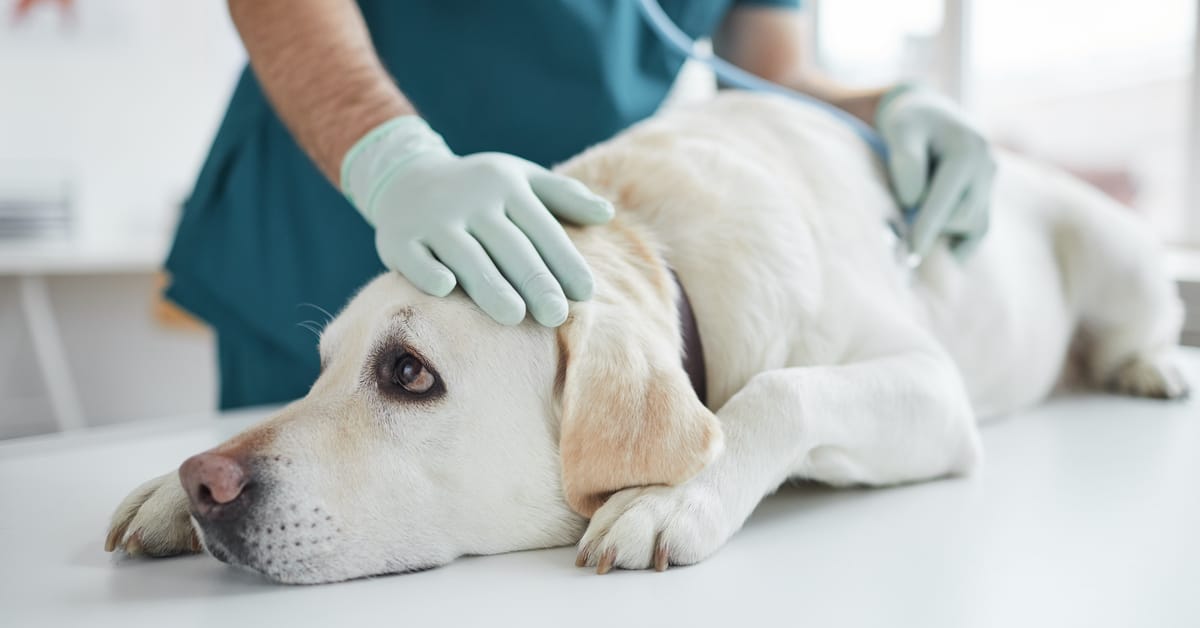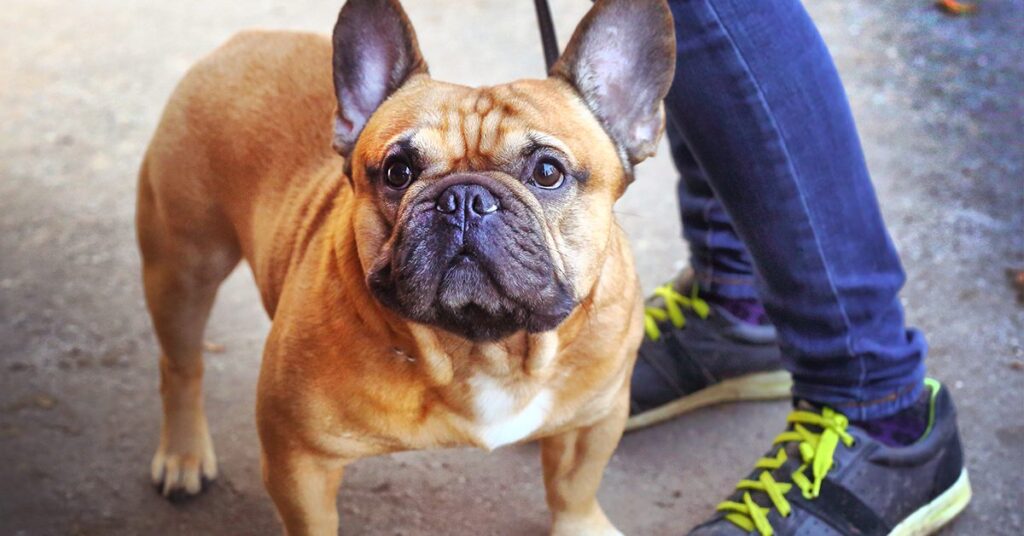One of the most frightening things a pet owner can experience is a dog seizure. If your dog has a seizure, you may see a number of abnormalities like paddling of the legs, foaming around the dog’s mouth, drooling, and even loss of consciousness.
It’s also common for dogs to exhibit unusual or aggressive behavior following a seizure. I remember one poor family who called the emergency clinic where I worked to tell me their dog had trapped them in a room of their house.
I told them that what they were describing sounded like the dog might have had a seizure and was behaving aggressively after recovering, which is normal. Then I let them know that the dog was probably fine now, but they asked for an animal control officer to come to get the dog. When the officer got there, the dog was fine and acting normally.
This is an extreme example, but it’s a good illustration of just how unusual a dog’s behavior can become following a seizure. It’s a scary possibility so let’s talk about why dogs get seizures, what a seizure can look like, and what to do if your dog has a seizure.

What are the Causes of Seizures in Dogs?
The biological cause of seizures in dogs is an abnormal electrical activity that is happening in their brain. So what’s causing the abnormal electrical activity?
Well, it could be a brain tumor, but that’s not the most common cause. There are a number of other causes of seizures including liver disease, brain trauma, and poisoning. When your dog has a chronic condition of seizures, meaning they happen frequently, your dog may be diagnosed with epilepsy.
Epilepsy can result from any of the above-mentioned diseases or trauma, or it may not have an identifiable cause. When the exact cause is unknown, it is called idiopathic epilepsy. This condition is inherited, but the specific cause for it has not been identified.
Idiopathic epilepsy is the most common cause of seizures in dogs. It is estimated that approximately 1 in every 130 dogs may suffer from idiopathic epilepsy.
Are There Certain Dog Breeds that are More Prone to Seizures?

There are certain dog breeds that are more likely to suffer from epileptic seizures. They include:
- Labrador retrievers
- Golden retrievers
- Belgian tervurens
- Shetland sheepdogs
- Beagles
- Keeshonds
- Vizslas
- Bernese mountain dogs
- Irish wolfhounds
- English springer spaniels
- Finnish spitz
In dog breeds with a genetic predisposition to seizure disorders, symptoms most often begin between about 10 months and 3 years of age. Problems can begin as early as 6 months of age or as late as 5 years, but that is not as common.
It is also true that male dogs are more prone to problems with seizures than female dogs are, and that’s another indicator of the genetic component of this problem.
What Happens During a Seizure?

The medical term for a seizure is ictus, and there are typically three phases to a seizure. Here’s what normally happens in each phase.
1. The Pre-Ictal Phase
This is also known as aura. This is the period right before a seizure when it seems as if your dog senses that something is going to happen. He may show a change in his normal behavior.
Your dog might hide or he might not want to let you out of his sight. He might seem nervous and be whining, drooling, or shaking.
2. The Ictal Phase
This is when your dog is actually having a seizure. It can last from just a few seconds to several minutes. The symptoms of seizures can also vary from being as mild as a dazed look to a full-blown grand mal seizure where he loses consciousness and demonstrates widespread muscle twitching.
This kind of seizure activity also usually causes urination and defecation as well as excessive drooling. Usually, most seizures don’t last for very long. If it lasts for longer than five minutes, that is called status epilepticus, which is life-threatening. If this happens, get your dog to a veterinarian immediately so he can get some seizure medication to stop it.
3. The Post-Ictal Phase
During this phase, your dog is often confused and disoriented. He may exhibit uncharacteristically aggressive behavior, restlessness, and even temporary blindness.
It’s important to remember that with a generalized seizure, every muscle in your dog’s body has been twitching uncontrollably because of the abnormal electrical activity happening in his brain. That has to be exhausting and disorienting. It’s no wonder he might suffer some side effects after the seizure has stopped.
Most of the time, these side effects will subside within a few minutes or hours, but sometimes that happens more slowly over the next day or even a few days.
Are There Different Types of Seizures?

There are different kinds of seizures a dog can have, and each can look different. Here are the main kinds of seizures you might see:
Focal or Partial Seizures
Focal seizures in dogs only affect one-half of the brain. They also usually only occur within a particular region of that half. These seizures can either be simple or complex. That determination is made based on your dog’s level of awareness while the seizure is happening.
A simple focal seizure is one where your dog remains conscious. If he loses consciousness or his awareness is impaired, that’s considered a complex focal seizure.
Your dog may be having a focal seizure if he is moaning, barking, or growling at nothing, biting at the air, or being fearful for no reason. These are indicators he might be having a hallucination because of the seizure. He might also show signs of vision or hearing changes, dilated pupils, problems with balance, involuntary movements, or muscle twitching.
Generalized Seizures
These types of seizures affect both sides of your dog’s brain. A generalized seizure may start out as a focal seizure but evolve to affect both sides of the brain. Typically, your dog will lose consciousness during this kind of seizure, and he may also urinate or defecate.
There are different categories of generalized seizures, and they include the following:
- Tonic: This involves muscle contractions or stiffening.
- Clonic: These are involuntary, rapid, and rhythmic muscle contractions/jerking.
- Tonic-Clonic: This is when the contractions start out as tonic and then are followed by a clonic phase.
- Myoclonic: This category involves sporadic jerks that occur on both sides of the body.
- Atonic: This category of seizures is also called ‘drop attacks.’ The name comes from the fact that these seizures can cause the dog to suddenly collapse.
- Cluster: This refers to two or more seizures in a 24-hour-period. Your dog will fully regain consciousness between each seizure.
- Status Epilepticus: This refers to either one seizure that lasts longer than 5 minutes or several seizures that occur in a short period of time in which the dog does not regain full consciousness. This is life-threatening, and you should get your dog to a vet immediately if this is happening.
What To Do if Your Dog Has a Seizure

Despite the violent appearance of many types of seizures, your dog is not consciously experiencing pain while this is happening. He may throw his head back, urinate, defecate, and drool excessively, but it looks much worse than it feels. So what can you do? Keep reading to learn what to do if your dog has a seizure.
The most important thing to do is stay calm. Your dog needs you right now, so you want to focus on how you can help him. Here are several first aid recommendations to prevent him from hurting himself and take care of him afterward:
- Check the time: You want to know when your dog’s seizure started and how long it lasted. If your dog experiences cluster seizures, you want to note the length of time between seizures. You should take him to the vet immediately
- Film the seizure: If someone else is around, you can ask them to film the seizure so you can show it to your DVM when you get your dog checked afterward.
- DO NOT EVER put your fingers or any other object in your dog’s mouth: He cannot swallow his tongue. This is also true for people, by the way. If you put your fingers in his mouth, you’re likely to get bitten. If you put an object in his mouth, that creates a choking hazard. Don’t do either!
- Cushion your dog’s head: You can cushion your dog’s head to prevent him from hurting himself. You can also keep him away from stairs or other areas where he may fall. Just hold him gently and comfort him until he comes around.
- Cool your dog down: If the seizure lasts for just a minute, you don’t need to do this, but if it lasts for more than 2 or 3 minutes, your dog’s body temperature can rise to a dangerous level. You can use a wet towel or cold water and apply it to his groin, neck, paws, and head to help cool him down. If the seizure is going on this long, you want to be heading to your veterinarian.
- Get your dog checked by the veterinarian: If the seizure goes on for longer than 2 minutes or doesn’t stop, go to the vet immediately. But even if it does stop, it’s a good idea to get your dog checked out even though he seems to be okay.
- Keep a journal: Once your dog has had a seizure, you want to start a journal to document that seizure and any more that he may have. You should always note the date, time, and length of the seizure activity. This can help the vet to determine if there’s a pattern.
- Document cluster seizures: If your dog has more than one seizure over the course of a 24-hour period, this is known as cluster seizures. These require immediate veterinary attention. You still want to note the date, time, and length of each seizure as well as the time between seizures. That will help your DVM to figure out what’s going on.
My Dog Had a Seizure. Now What?

Whether your dog had a seizure that lasted a few minutes or is still in a state of status epilepticus, you’ll want to take him to the vet to get an examination. The first thing your vet will want to know is his thorough history.
They will look for things like possible exposure to poison or drugs, any history of head trauma that could have resulted in brain damage, and any other symptoms your dog may have had recently. If you were able to see what your dog was doing right before the seizure, that could also be helpful information.
After taking your dog’s history, the veterinarian will perform blood work to rule out metabolic imbalances, electrolyte or blood sugar levels problems, liver disease, kidney disease, and parasitic problems like heartworms.
If these tests come back normal and there is no evidence of exposure to poison or recent trauma, your veterinarian may recommend other diagnostic tests that can dig a little deeper. If this was your dog’s first seizure and he doesn’t experience another, then that may not present a problem that is overly worrisome.
However, if he experiences more seizures or they become more severe, your veterinarian may want to do a spinal fluid analysis and other specialized tests like a CT scan or an MRI. These will allow a neurologist to visualize the structure of your dog’s brain.
How Do Veterinarians Treat and Prevent Seizures?

Your veterinarian will usually only recommend ongoing seizure treatment if your dog has more than one seizure per month, is experiencing cluster seizures, or is having grand mal seizures that are severe or prolonged.
If they do recommend treatment, the most common anticonvulsant medications used are phenobarbital and potassium bromide. There are other anticonvulsants they may recommend such as levetiracetam, which goes by the brand name Keppra®, and zonisamide, also known as Zonegran®. If your dog doesn’t respond well to these drugs, your veterinarian may also try combination therapy.
Of course, the best treatment is prevention. You can help prevent seizures in your dog by getting them regular checkups to ensure they are healthy. You also want to make sure you store any kind of toxin out of your dog’s reach.
That includes certain plants or any human drugs that may be in the house. For example, Ibuprofen is toxic to dogs and can cause seizures.
What To Do if Your Dog Has a Seizure: Final Thoughts

Seizures are one of the most disturbing and concerning medical problems a dog owner can experience. They appear very traumatic even if they’re really not that bad. If your pet has a seizure, you want to get him checked, but it may be just a one-time thing. If it isn’t, there are medications that can help.
The key is to be observant, stay calm, don’t put anything in his mouth, support his head, and keep him away from things that can hurt him until the seizure passes. If it lasts longer than 5 minutes, get him to the vet immediately. You’ll want to get him checked out afterward anyway. It isn’t the end of the world, but it is something that requires your attention so you can do what’s best for your best friend.

